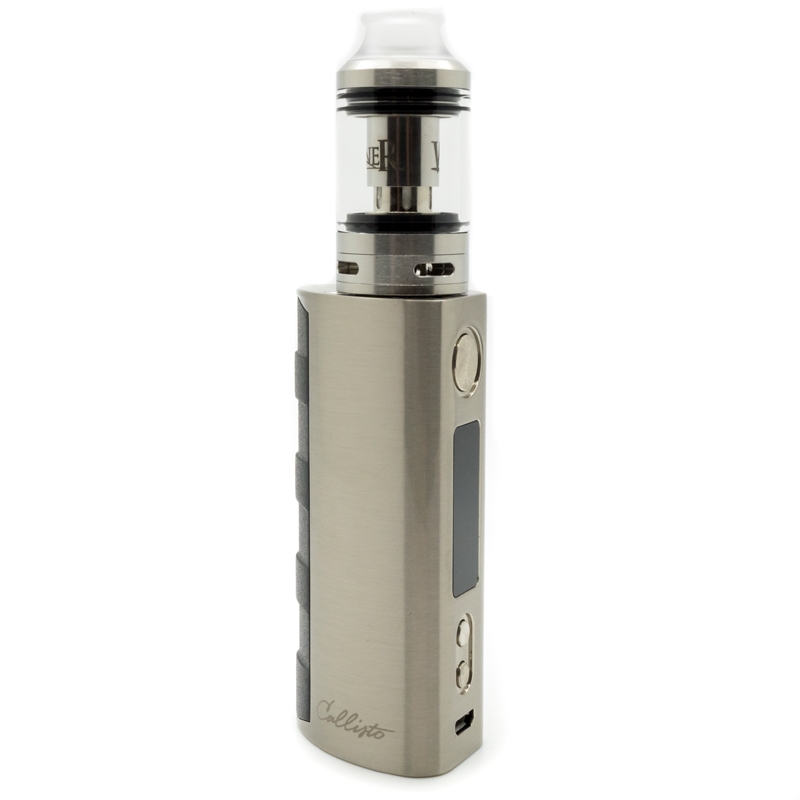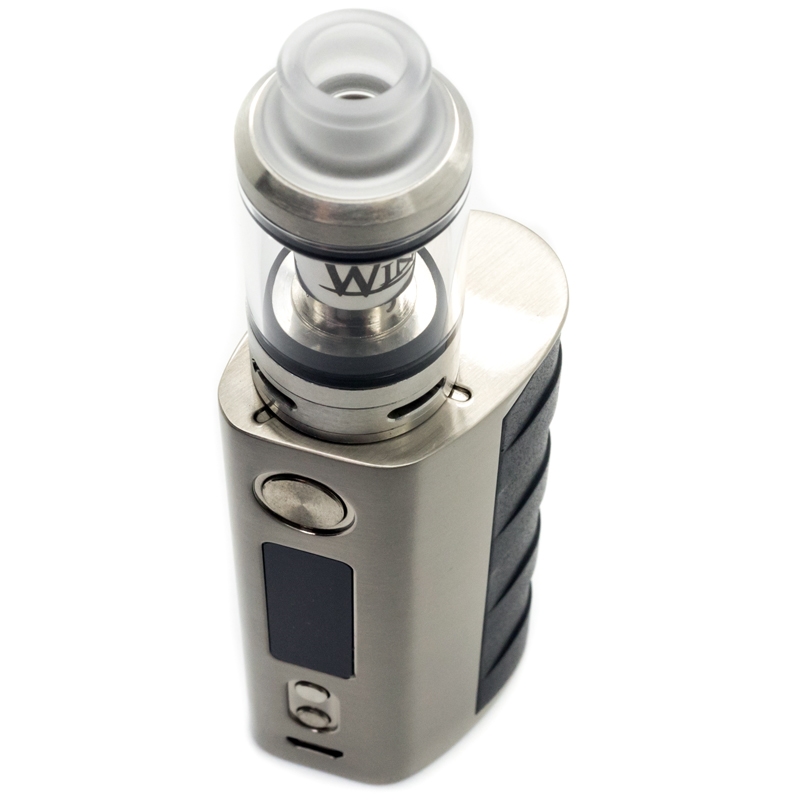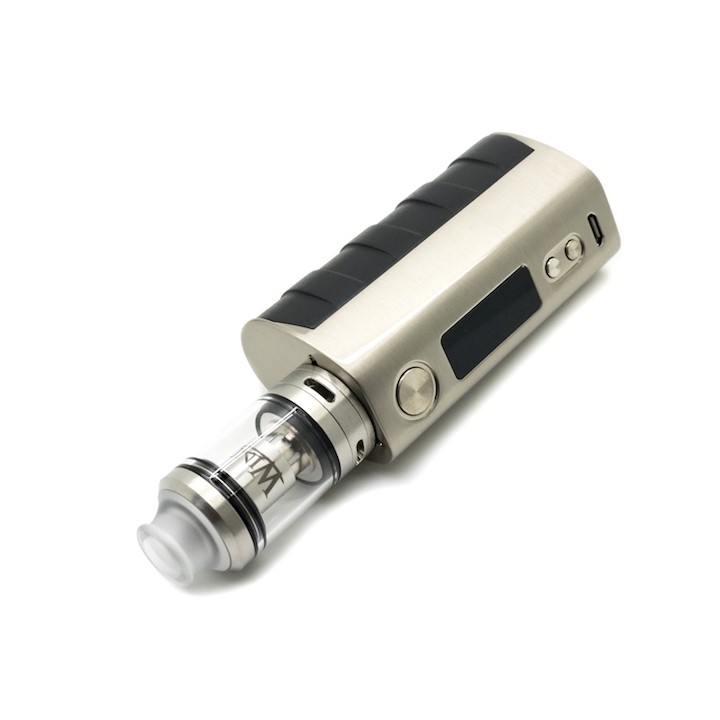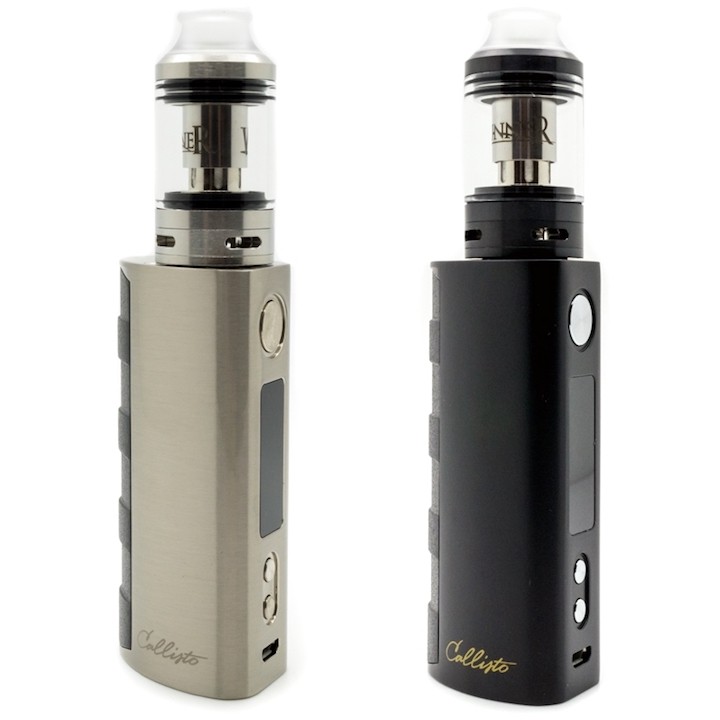Table of Contents [show]
I usually believe first impressions are lasting impressions. But the Council of Vapor Callisto Mod (CoV) has me rethinking things. Because, while this American-designed device – and accompanying Windrunner tank – certainly makes a strong first impression, I walked away from this kit with a really sour taste in my mouth, figuratively and literally.
Sadly, let’s dive in…
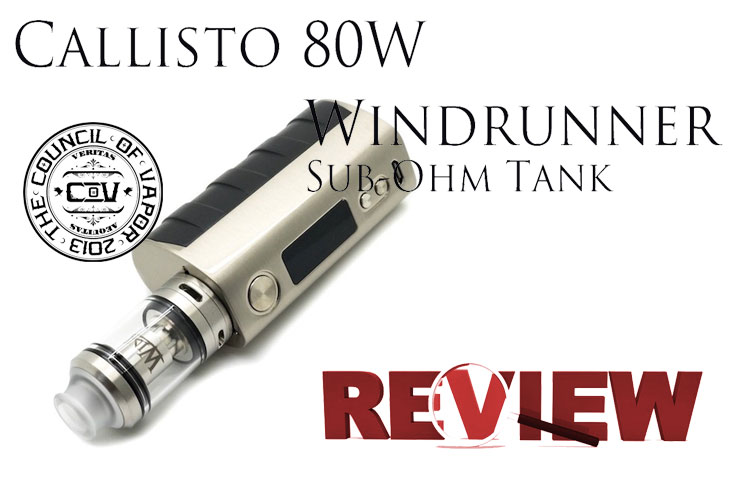
Initial thoughts on the Council of Vapor Callisto Mod
Coming in a massive black box, with nothing more than an embossed company logo, it’s difficult at first to discern which device is inside. My initial thought was that the Callisto was a sizable mod. I would be wrong.
Opening the box reveals one of the most diminutive 80-watt devices I’ve seen to date. With an asymmetric design, not unlike a narrower, warped Wismec Reuleaux RXMini, the Callisto is a sharp looker, with a nice, textured grip on the back side of the mod, and an off-angle screen/button placement that feels good in either hand.
All functional areas, from screen to buttons to USB port, are relegated to this angled section, making the Callisto extremely comfortable to hold. However, one thing I noticed is the complete lack of visible vent holes. CoV seems to have packed a lot of power into this single-18650 device, and the dearth of venting concerned me.
That said, even without a battery installed, the CoV Callisto has a solid heft to it, and the ergonomic styling will make this a unique option for Vapers looking to add a subtle, stealthy option to their collections.
The rest of the box contains the included Windrunner tank, an extra coil, USB cable, spare glass, some O-rings and parts, and a veritable boatload of documentation and branded cards. The instruction manuals are minimalist, but relatively well-translated, which I would expect from a US-owned company, even if the Callisto was made in China.
Powering up the Callisto
After installing a fresh 18650 into the snug battery slot, the workmanlike screen came to life, with all of the information users would want, and little more. By that, I mean wattage, temperature, coil resistance, voltage and mode indicator. It’s a soft blue readout that works well, even on sunny days, and after being inundated with overthought displays lately, I found the simplicity refreshing.
However, getting through the CoV board’s menu system was another animal entirely. Though the functionality is no different than the myriad other menu systems we’ve tested, the button presses never seemed to sync up with the onscreen actions. The buttons themselves are solid metal, and have a nice click/throw to them, but when trying to simply move through the option tree, holding the fire key sometimes moved me ahead, other times moved me backwards.
Heck, even the five clicks required to enter the menu didn’t always register, making something as simple as moving to TC mode a logistical nightmare.
Quirky disconnects aside, the CoV Callisto board offers a pretty good suite of options for such a small device. Offering temperature control that supports nickel, titanium and stainless-steel coil builds, I found all three modes to work as advertised, recognizing the coil and adjusting wattage accordingly.
However, TC tinkerers will have to look elsewhere than the Callisto mod, because the device does not allow users to adjust wattage on their own when in temperature control. It does a fairly adequate job of detecting the right wattage for your settings, but having this level of control taken away is an oddity.
There is also no TCR mode, but this makes sense on a device clearly not designed for massive, overcomplicated builds. The existing settings are more than adequate for the nature of the device.
Fly away, Windrunner Tank…
The included Windrunner tank is a confusing little device. For starters, it appears both modern and strangely antiquated, save for the unified ultem resin drip tip/top cap combo. Otherwise, the tall 0.2-ohm coil is a throwback to those simpler, less-complicated Kangertech days.
Yet, the low-resistance coil build and significant juice flow ports indicate the Windrunner is a sub-ohm tank on par with SMOK’s Baby Beast, when in reality, it’s much better suited for restricted lung, and even loose MTL use. The 2.5mL capacity Windrunner isn’t exactly a Taifun, but the coils here are simply not capable of high-wattage cloud production.
Putting together the Windrunner seems simple enough, but on several occasions, I found the coil stuck to the top portion of the chimney, rather than staying put in the base as intended. In fact, I found the coil coming loose from the base more often than not, leading the Windrunner’s biggest flaw – leaking.
This tank leaked like a sieve, from the moment I primed and filled it. Using all the usual steps and precautions, the Windrunner nonetheless flooded the bottom airflow chamber countless times, and each time I took it apart to make adjustments, there was the coil coming loose from the cheap-ish threading.
Both included coils produced similar results for leaking, and for vape performance. Even within the recommended 30-50 watt range, the 0.2-ohm coils just couldn’t keep up with moderate vaping, and dry hits abounded throughout my experience. Whatever cotton comprised these coils was clearly too tight and stiff to promote appropriate juice flow, and within minutes, every puff was bone dry.
The Windrunner tank itself seems fairly well made, with decent machining and threading. In turn, the unified drip-tip and top cap do a good job keeping the vape cool on the lips. But this proprietary coil system muted the flavor of even my most potent e-liquids, and even dialed down the impact of higher nicotine concentrations when trying to use the tank as an MTL device.
There was better performance from the Windrunner in MTL and restricted lung usage, but even then, the flavor was still a touch weak, and the vapor was wispy and unsatisfying. Plus, there was an increase in leaking due to use of thinner, higher-PG e-liquids.
It’s sincerely unfortunate that the simplified, no-nonsense design of the Windrunner wasn’t matched by no-nonsense performance. It’s repeated lack of flavor and inexcusable leaking make this a loss for CoV.
Vaping the Callisto
How did the Callisto fare with other tanks? Better than it did with the Windrunner, but that isn’t exactly a glowing testimonial, based on what you just read.
Using a series of similarly sized tanks and RTAs, I found the CoV Callisto mod to be adequate, with some quirks. Aside from the afore-mentioned menu selection concerns, I also had repeated bouts of misfiring with the Callisto, regardless of which tank was in use at the time.
Somewhat ironically, I found the Callisto to offer much better performance in temperature control mode, with no misfires or coil reading concerns when used in this manner. Regardless of which coil material I employed, the temp readings were accurate, and the vape quality highly enjoyable.
However, back in wattage, things weren’t so rosy. Using the Callisto at its max 80 watts offered some punchy hits with these comparable tanks, but it clearly taxed the device to do so at a regular clip. Not only did the mod become insanely hot at this wattage level – remember what I said about venting earlier – but battery life depleted at an unbelievable rate.
I kid you not, on one fully charged 18650, at 80 watts, the Callisto offered me just under one hour of semi-frequent vaping. I swapped the batteries, changed the atomizer, and dialed the device back to 55 watts, and battery life only improved by maybe 15 minutes.
Even my wife’s experience was frustrating. Loaning her the Callisto for an evening of strict MTL vaping, never exceeding 18.5 watts, the mod depleted at nearly the same pace, and within a few hours of semi-moderate use, the battery needed to be swapped once more.
Wrapping up...
While it lasts (and when it works), the vape quality of the Callisto is decent. There was no noticeable pulse or lack of power, other than during the misfires I mentioned earlier. Hits were smooth, the buttons were responsive, and it was a fair experience, overall. But it simply doesn’t last long enough to recommend the Callisto over a slew of longer-lasting, more consistent vape devices.
When coupling this with the previously mentioned menu confusion, the Callisto becomes even more frustrating to use. And there are far too many GREAT experiences available today to spend too much time and money on something so average. Perhaps these are harsh words, but that’s because of my admittedly high expectations for the Callisto and the Windrunner.
GRADE: D-
I only hope the Windrunner tank and coils I received were anomalies, and not the desired experience Council of Vapor intended when releasing this kit. Because, between the Callisto’s short-lived battery life, and the tank’s unforgivable leaking, this experience is memorable for all the wrong reasons.
Available at Element Vape for $49.95
Specs and Contents
Council of Vapor Callisto 80W specs:
- Dimensions: 78mm by 41.6mm by 27.5mm
- Wattage Output Range: 10-80W
- Min Atomizer Resistance: 0.1ohm
- Temperature Control Range: 200-600F
- Support Ni200 Nickel, Titanium, and Stainless-Steel Heating Element
- High-Quality Zinc Alloy Construction
- Textured Paint Battery Cover – Magnetized
- Oversized Firing Mechanism
- OLED Display
- Micro USB Port
- 510 Connection
Council of Vapor Windrunner tank specs:
- 22mm Diameter
- 2.5mL Juice Capacity
- 0.2ohm Vertical Coil – rated for 30-50W
- Convenient Threaded Top-Fill Design
- Quad Bottom Airflow Control
- 510 Wide bore Drip Tip
- Knurled Top Cap
- 510 Connection
Starter Kit Includes:
- 1 Callisto 80W Box Mod
- 1 Windrunner Sub-Ohm Tank
- 2x 0.2ohm Coil Head
- 1 Replacement Glass Tube
- 1 MicroUSB Cable
- Spare O-Rings
- Instruction Manual



